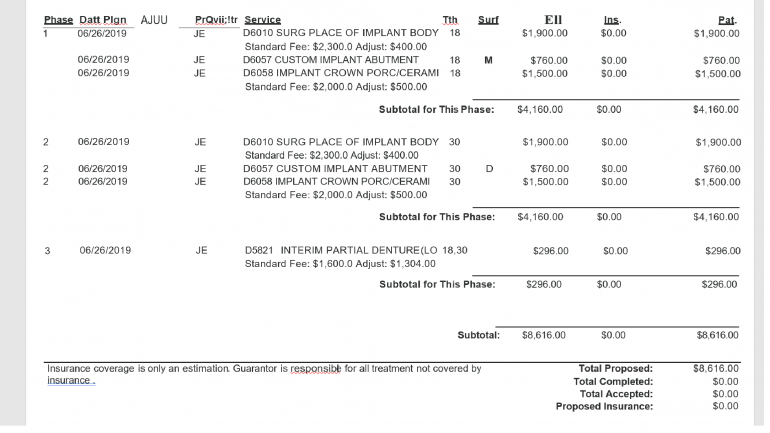
Dental Code D5130: Immediate denture - maxillary
Dental Code D5130 refers to the immediate denture procedure for the maxillary (upper) arch. This code is used to describe the process of creating and fitting a removable denture for the upper jaw, which is placed immediately after the extraction of the remaining natural teeth in the same arch. Immediate dentures are designed to restore both the functionality and aesthetics of the patient's smile during the healing period before permanent dentures or other restorative options can be considered.
Initial Consultation and Examination
During the initial consultation, the dentist will assess the oral health and discuss the expectations and concerns regarding the immediate denture. They will evaluate the condition of the remaining teeth, gums, and supporting bone structure. This assessment helps in determining if immediate dentures are suitable for the patient.
If it is determined that immediate dentures are the right option for the patient, the dentist will explain the procedure in detail and address any questions or concerns the patient may have. They may also take X-rays or use other imaging techniques to gather additional information about the oral structures.
Impressions and Bite Registration
Once it is established that immediate dentures are the appropriate treatment option, the dentist will take impressions of the upper arch. These impressions capture the shape and contours of the gums, which are used as a mold for fabricating the denture. Bite registration is also performed to record the relationship between the upper and lower jaws, ensuring proper alignment of the denture.
To take the impressions, the dentist will use a soft and malleable material called alginate. Alginate is placed in a tray and inserted into the mouth, allowing it to conform to the shape of the upper gums. It usually takes a few minutes for the alginate to set, after which the impressions are carefully removed.
For the bite registration, the dentist will have the patient bite into a soft, dough-like material called wax. This helps them determine the correct position of the upper and lower jaws when the teeth come together.
Denture Fabrication
Using the impressions and bite registration, a dental laboratory will fabricate a custom-made immediate denture for the upper jaw. Skilled technicians will carefully craft the denture, taking into consideration the shape, size, and color of the natural teeth for a natural-looking result. The denture will be made from a durable and biocompatible material.
The fabrication process involves pouring a plaster-like material into the impressions to create stone models of the upper arch. These models serve as a foundation upon which the denture is constructed. The technician will use these models to shape a wax framework that replicates the contours of the gums and the arrangement of the teeth.
Once the wax framework is completed, the technician will try it in the mouth to assess the fit and aesthetics. Any necessary adjustments are made at this stage before the final denture is processed. The final denture is typically made from acrylic or a similar material, which is customized to match the color and appearance of the natural teeth.
Extractions and Denture Placement
On the day of the procedure, any remaining teeth in the upper arch that need to be extracted will be removed. Local anesthesia is typically administered to ensure comfort during the process. The extraction sites are carefully cleaned and prepared for the immediate denture.
Immediately following the extractions, the immediate denture will be placed in the mouth. The denture is adjusted to fit snugly against the gums and jawbone. The dentist will ensure that the denture provides proper support and stability while allowing the patient to speak and chew comfortably.
Post-Placement Adjustments and Healing
After the immediate denture is placed, the dentist will make necessary adjustments to ensure proper fit, comfort, and bite alignment. They will evaluate the occlusion (how the upper and lower teeth come together) and make any necessary modifications to ensure a balanced bite. These adjustments may involve adjusting the shape and contour of the denture or making selective adjustments to specific areas.
It's important to understand that immediate dentures are placed immediately after extractions, which means that they are designed to accommodate the changes that occur during the healing process. the mouth will undergo a natural healing period during which the gums and underlying bone will reshape and change. As a result, the fit of the denture may become less precise over time.
Summary of Dental Code D5130
Dental Code D5130 refers to the immediate denture procedure for the upper jaw. This procedure involves an initial consultation and examination, followed by taking impressions and bite registration to create a custom-made denture. The denture is fabricated in a dental laboratory using high-quality materials. On the day of the procedure, any remaining teeth in the upper arch are extracted, and the immediate denture is placed immediately. Post-placement adjustments and healing are necessary to ensure proper fit, comfort, and bite alignment.
Immediate dentures provide several benefits, including the restoration of the smile, improved speech, and the ability to eat with greater ease. They also help protect the extraction sites and aid in the healing process. However, it's crucial to understand that immediate dentures are considered a temporary solution, as the shape of the gums and bone will change during the healing period. Once the healing is complete, the dentist may recommend a permanent denture or other restorative options for a more long-term solution.
Explore budget-friendly dental solutions at
Dr. BestPrice! Navigate costs, select wisely, and relish high-quality dental services without the hefty price.